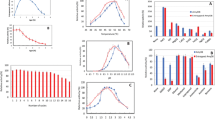Abstract
Growing cells of a thermophilic strain ofBacillus brevis, producer of thermostable α-amylase, were immobilized by entrapment in agar gel. Optimum immobilization conditions for effective α-amylase production in batch fermentations were established (gel concentration 3%, initial biomass concentration in the gel 0.8% (W/V), and preculture age—late exponential phase). The dynamics of α-amylase synthesis by the biocatalysts obtained under the optimal conditions was compared with that of free cells and the operational stability of the biocatalysts was studied in semicontinuous cultivation experiments. Maximum α-amylase yields (252% of the control) were achieved after the second cycle of cultivation. Scanning electron microscopy was used to characterize the bacteria entrapped in agar gel.
Similar content being viewed by others
References
Beschkov M., Emanuilova E., Tonkova A., Kosturkova P., Dobreva E., Loginova L., Tsaplina I.: StrainBacillus brevis for production of thermostable α-amylase.Bulg. Pat. 39 900 (1986).
Chevalier P., Noue J.: Enhancement of α-amylase production by immobilizedBacillus subtilis in an airlift fermenter.Enzyme Microb. Technol. 9, 53–56 (1987).
El-Sayed A.-H.M.M., Rehm H.-J.: Morphology ofPenicillium chrysogenum strains immobilized in calcium alginate beads and used in penicillin fermentation.Appl. Microbiol. Biotechnol. 24, 89–94 (1986).
Ivanova V., Stefanova M., Tonkova A., Dobreva E., Spasova D.: Screening of a growing cell immobilization procedure for the biosynthesis of thermostable α-amylases.Appl. Biochem. Biotechnol. 50, 305–316 (1995).
Jamuna R., Saswathi N., Sheela R., Ramakrishna S.V.: Synthesis of cyclodextrin glycosyl transferase byBacillus cereus for the production of cyclodextrins.Appl. Biochem. Biotechnol. 43, 163–176 (1993).
Jouenne T., Tresse O., Junter G.-A.: Agar entrapped bacteria as anin vitro model of biofilms and their susceptibility to antibiotics.FEMS Microbiol. Lett. 119, 237–242 (1994).
Kanasawud P., Hjorleifsdottir S., Holst O., Mattiasson B.: Studies on immobilization of the thermophilic bacteriumThermus aquaticus YT-1 by entrapment in various matrices.Appl. Microbiol. Biotechnol. 31, 228–233 (1989).
Klingeberg M., Vorlop K.D., Antranikian G.: Immobilization of anaerobic thermophilic bacteria for the production of cell-free thermostable α-amylases and pullulanases.Appl. Microbiol. Biotechnol. 33, 494–500 (1990).
Nilsson K., Birnbaum S., Flygare S., Linse L., Schroder U., Jeppson U., Larsson P.-O., Mosbach K., Brodelius P.: A general method for the immobilization of cells with preserved viability.Eur. J. Appl. Microbiol. Biotechnol. 17, 319–326 (1983).
Pantchev C., Klenz G., Häfner B.: Vergleichende Charakterisierung von Alpha-Amylasepräparaten.Lebensmittelindustrie 28, 71–74 (1981).
Shinmyo A., Kimura H., Okada H.: Physiology of α-amylase production by immobilizedBacillus amyloliquefaciens.Eur. J. Appl. Microbiol. Biotechnol. 14, 7–12 (1992).
Stefanova M., Emanuilova E.: Characterization of a thermostable α-amylase fromBacillus brevis.Eur. J. Biochem. 207, 345–349 (1992).
Tonkova A., Ivanova V., Dobreva E., Stefanova M., Spasova D.: Thermostable α-amylase production byBacillus licheniformis cells in agar gel and on acrylonitrile acrylamide membranes.Appl. Microbiol. Biotechnol. 41, 517–522 (1994).
Tsvetkov V., Emanuilova E.: Purification and properties of heat stable α-amylase fromBacillus brevis.Appl. Microbiol. Biotechnol. 31, 246–248 (1989).
Author information
Authors and Affiliations
Rights and permissions
About this article
Cite this article
Stefanova, M.E., Tonkova, A.I., Dobreva, E.P. et al. Agar gel immobilization ofBacillus brevis cells for production of thermostable α-amylase. Folia Microbiol 43, 42–46 (1998). https://doi.org/10.1007/BF02815540
Received:
Issue Date:
DOI: https://doi.org/10.1007/BF02815540




